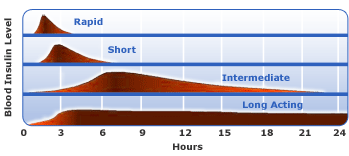
|
|
|||||||||||||||||||||||||||||||||||||||||||||||||||||||||||||||||||
| Typically, flexible insulin therapy (FIT) involves multiple daily injections of insulin:
One or two injections of intermediate or long-acting insulin each day. One injection is often taken at supper or bedtime. Another injection may be taken before breakfast. These injections keep a constant, low level of insulin in the bloodstream. (We call this a "basal level" of insulin.) Rapid- or short-acting insulin is taken before every meal. This injection delivers a quick insulin peak (called a "bolus") to cover the carbohydrates in the meal. By injecting fast-acting and long-acting insulin at different times during the day, you can copy the behavior of a healthy pancreas. Chart: Time-Action of Different Insulins
This chart compares the action of rapid-, short-, intermediate- and long-acting insulin over time. With Flexible Insulin Therapy, you take advantage of these different insulin characteristics to help control blood glucose.
Some people are able to reduce the number of daily injections by combining two types of insulin in one syringe. However, some insulins (such as Lantus), cannot be combined with other insulins. Insulin Doses Initially, your doctor will calculate how many units of insulin you should take throughout the day. The pre-meal insulin units set by your doctor are a starting point. Your doctor or diabetes educator will teach you how to adjust the mealtime insulin doses based on your pre-meal blood glucose level, how many carbohydrates you plan to eat, and how much exercise you expect to do after the meal. |
|||||||||||||||||||||||||||||||||||||||||||||||||||||||||||||||||||
